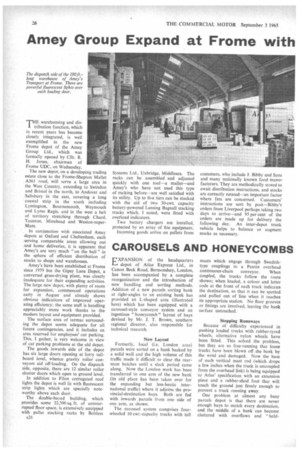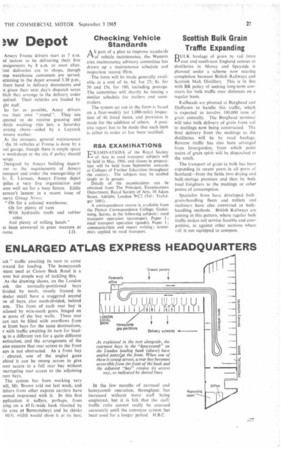CAROUSELS AND HONEYCOMBS
Page 28

Page 29

If you've noticed an error in this article please click here to report it so we can fix it.
EXPANSION of the headquarters 1-4 depot of Atlas Express Ltd., in Canon Beck Road, Bermondsey, London, has been accompanied by a complete reorganization and the introduction of new handling and sorting methods. Addition of a new parcels sorting bank at right-angles to an existing bank has provided an L-shaped area (illustrated here) which has been equipped with a carousel-style conveyor system and an ingenious "honeycomb" layout of bays devised by Mr. J. T. Brown, southern regional director, also responsible for technical research.
New Layout Formerly. local (i.e. London area) parcels were sorted on a bank backed by a solid wall and the high volume of this traffic made it difficult to clear the rearmost batches until a slack period came along. Now the London work has been transferred to one arm of the new bank (its old place has been taken over for the expanding but less-hectic international traffic) where it adjoins the provincial-destination bays. Both are fed with inwards parcels from one side of one arm, as shown.
The carousel system comprises fourwheeled 10 cwt.-capacity trucks with tall masts which engage through Swedishtype couplings to a Pantin overhead continuous-chain conveyor. When coupled, the trucks follow the route shown; when loaded, a colour and letter code at the front of each truck indicates the destination, so that it can be spotted and pulled out of line when it reaches its appropriate station. No floor grooves or fittings are involved, leaving the bank surface untouched.
Stopping Runaways Because of difficulty experienced in pushing loaded trucks with rubber-tyred wheels. alternative nylon wheels have been fitted. This solved the problem, but they are so free-running that loose trucks have been blown off the bank by the wind and damaged. Now the base of each vertical mast rod (which drops a few inches when the truck is uncoupled from the overhead link) is being equipped to Atlas' specification with an extension piece and a rubber-shod foot that will touch the ground just firmly enough to prevent a truck running away.
One problem at almost any busy parcels depot is that there are never enough bays to match every destination, and the middle of a bank can become cluttered with overflows and "held Ameys Fro= drivers start at 7 a.m, id reckon to be delivering their first )nsignments by 8 a.m, or soon after. lost deliveries are to shops, though
■ rne warehouse customers are served. eturning to the depot around 5.30 p.m., ivers hand in delivery documents and .e given their next day's dispatch notes hich they arrange in the delivery order quired. Their vehicles arc loaded by ght staff.
So far as possible, Amey drivers Lye their own round ". They are tpected to do routine greasing and :hick washing-this last, a Saturday orning chore—aided by a Laycock -essure washer.
At the moment, general maintenance the 16 vehicles at Frome is done by a cal garage, though there is ample space ir workshops at the site if policy should tange.
Designed by Ameys building departent to the requirements of Ameys ransport and under the managership of Ir. E. Larman, Ameys Frome depot pifies a very live organization and ems well set for a busy future. Eddie arman's lament in a recent issue of meys Group News: "Oh for a colossal warehouse; Oh for plenty of vans With hydraulic roofs and rubber sides And plenty of willing hands" is been answered in great measure at
Wine. J.D.




























































































































































